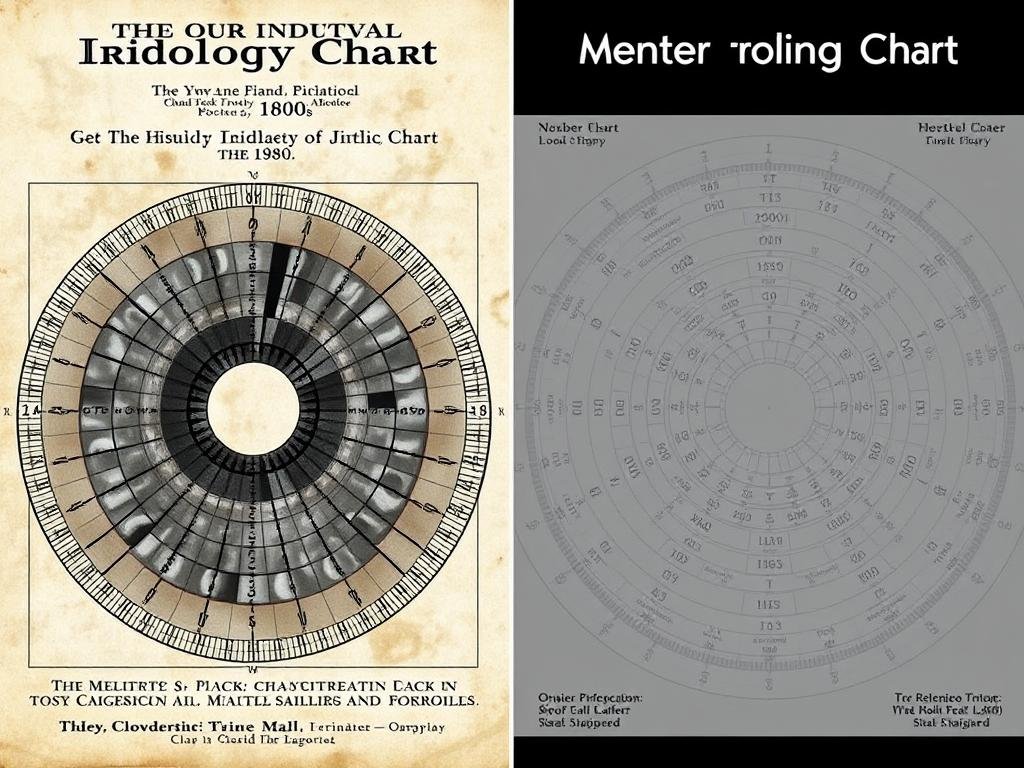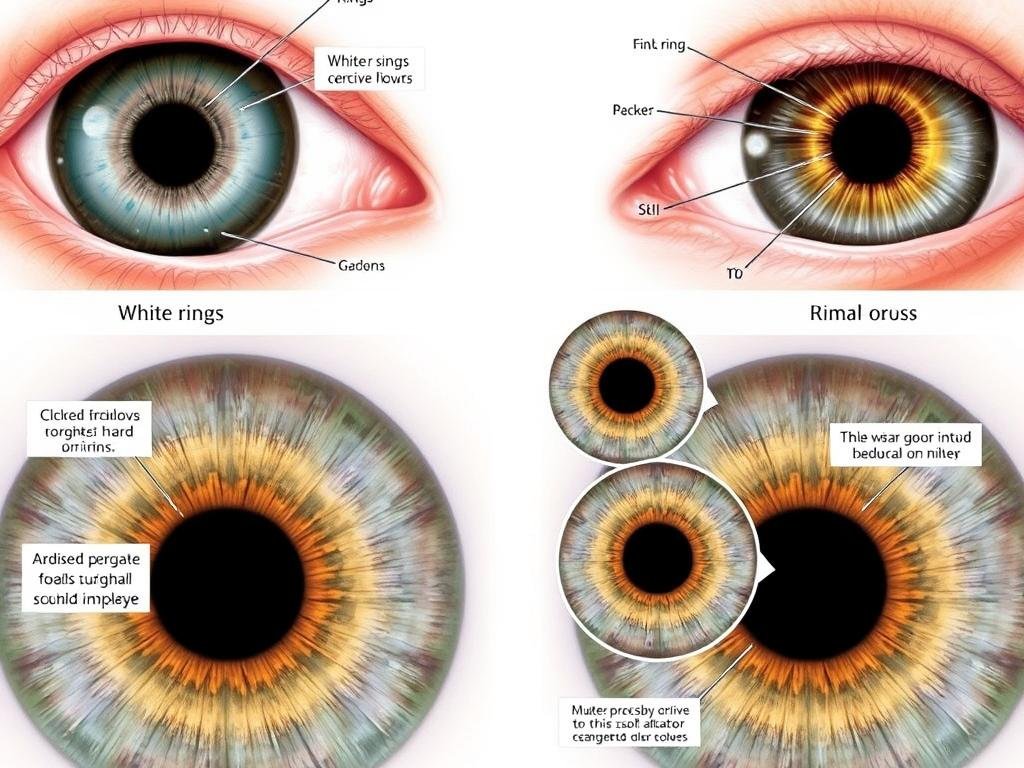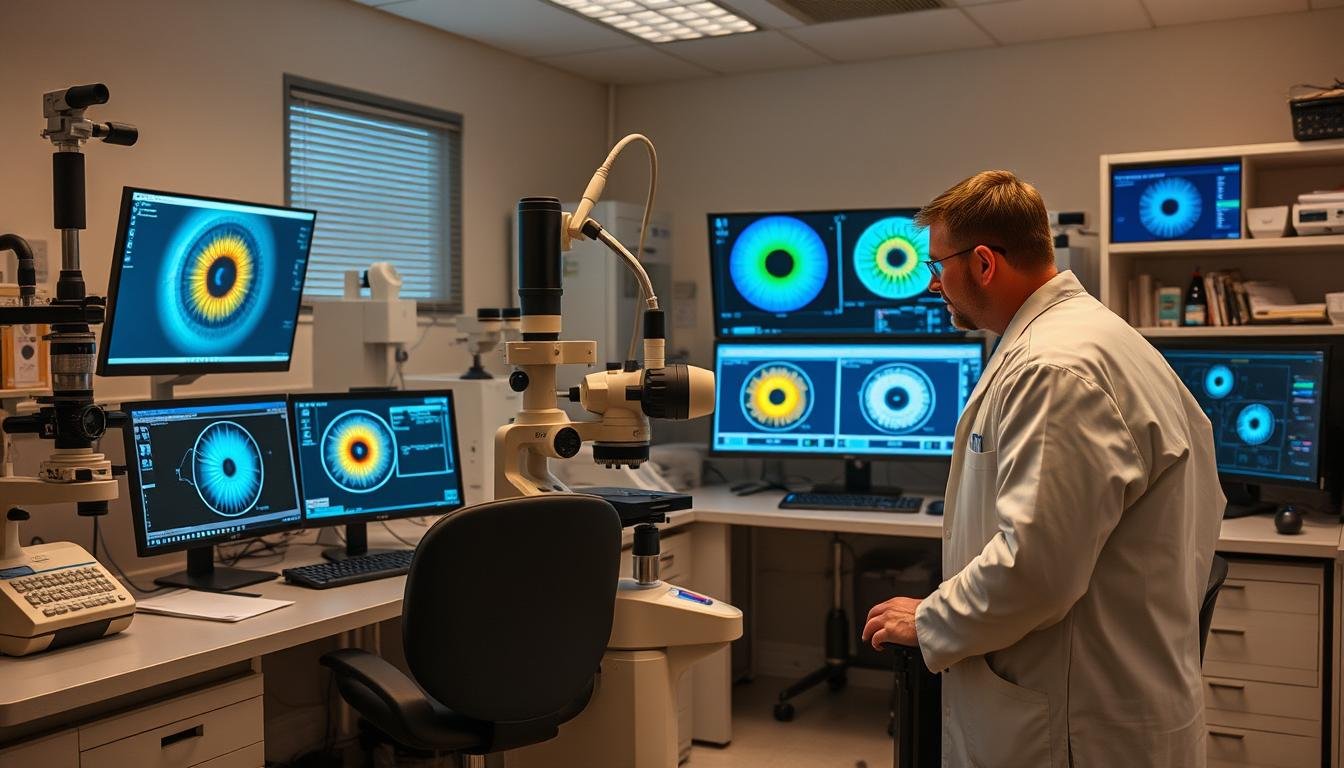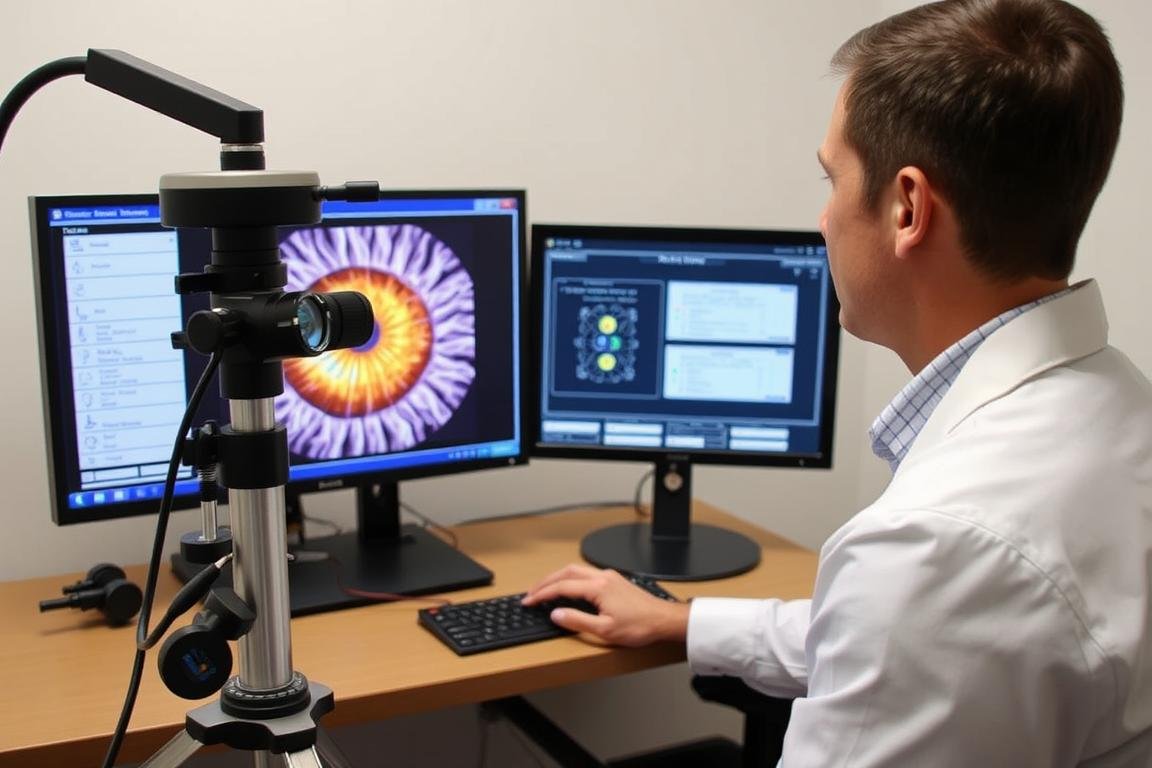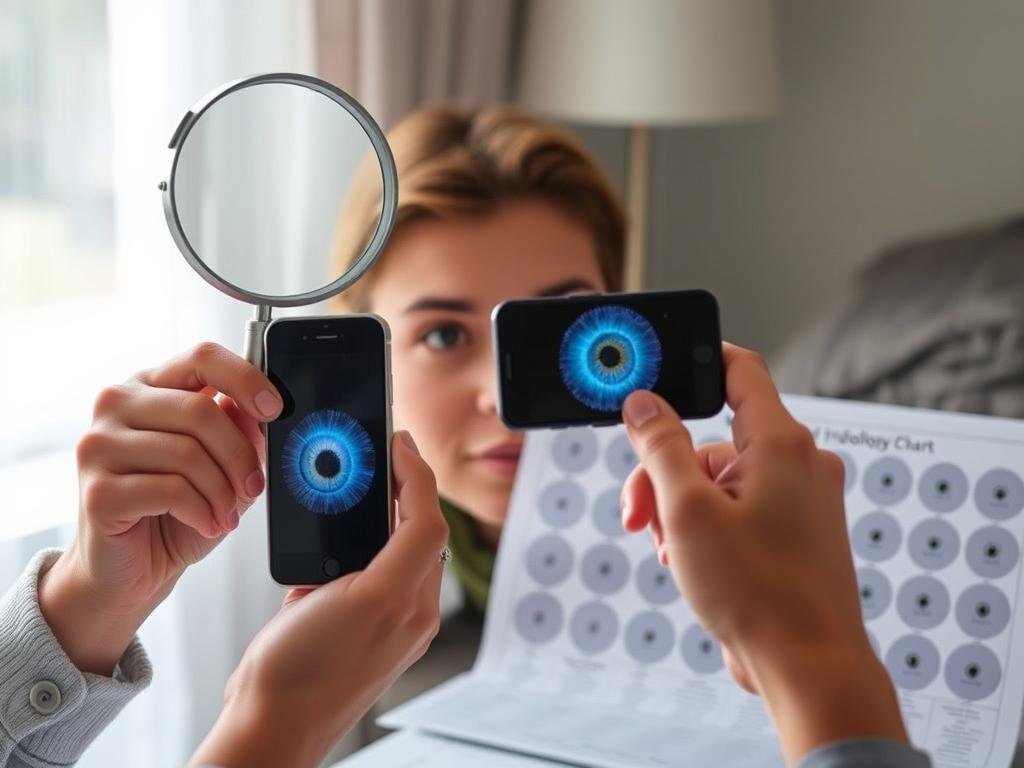The iris, that colorful part of your eye, may hold more information about your health than you realize. For practitioners of alternative medicine, the iridology chart serves as a detailed map to interpret the patterns, colors, and markings in your iris. This fascinating diagnostic tool divides the iris into zones that correspond to different organs and systems throughout the body. Whether you’re curious about alternative health practices or seeking to understand what those unique patterns in your eyes might mean, this comprehensive guide will walk you through everything you need to know about iridology charts and their interpretation.

A comprehensive iridology chart mapping the iris to various organs and body systems
What is an Iridology Chart?
An iridology chart is a diagnostic tool used by iridologists to map different areas of the iris to corresponding organs and systems in the body. These charts serve as reference guides that help practitioners identify potential health issues by examining changes, marks, or discolorations in specific regions of the iris. The practice of iridology is based on the theory that the iris contains a complete map of the body, with each section reflecting the condition of a specific organ or body part.
The concept of iridology dates back to the 17th century, but it was Dr. Ignatz von Peczely, a Hungarian physician, who developed the first comprehensive iridology chart in the 1800s. According to the story, he noticed changes in an owl’s iris after the bird suffered a broken leg, which inspired him to study the connection between iris patterns and physical health. Today’s modern iridology charts have evolved significantly but maintain the same fundamental principle: the iris reflects the state of health throughout the body.

The evolution of iridology charts from historical hand-drawn maps to modern digital versions
Understanding the Zones of an Iridology Chart
The iridology chart divides the iris into multiple zones, each corresponding to different parts of the body. These zones are arranged in a radial pattern, similar to a clock face, with the pupil at the center. The chart typically distinguishes between the right and left iris, as they often represent different sides or aspects of the body.
Right Iris Mapping on the Iridology Chart

Iridology Chart Left Eye – Iridology Chart – Left Eye
left eye reflects left side body.
| Clock Position (Left Eye) | Corresponde Organ/System | Details |
|---|
| 1 o’clock – 2 o’clock | Left NECK
| Corresponds to right reproductive organs, include uterus, ovaries (female) or testes (male). |
| 2 o’clock – 3 o’clock | Left LUNG | Ringflects health right joints, include knees, hips, elbows, and shoulders. |
| 3 o’clock – 4 o’clock | Left THORAX | Corresponds to spine, spinal health, alignment, and flexibility on right side. |
| 4 o’clock – 5 o’clock | Left UPPER ABDOMEN
| Ringflects bladder and left side urinary system. |
| 5 o’clock – 6 o’clock | Left LOWER ABDOMEN
| Ringpresents right colon, small intestine, and digestive health. |
| 6 o’clock – 7 o’clock | Left PELVIC
| Ringflects right kidney, focuse on filtration, detoxification, and fluid balance. |
| 7 o’clock – 8 o’clock | Left LOWER BACK
| Ringflects stomach and digestive organs on right side. |
| 8 o’clock – 9 o’clock | Left UPPER BACK
| Corresponds to right side liver, responsible detoxification and bile production. |
| 9 o’clock – 10 o’clock | Left THROAT
| Ringpresents right side heart, affecte cardiovascular health and circulation. |
| 10 o’clock – 11 o’clock | Left FACE | Ringflects right lung, respiratory health, and brea function. |
| 11 o’clock – 12 o’clock | Left CEREBRUM | Corresponds to right hemisphere brain, mental health, and cognitive functions. |
| 12 o’clock – 1 o’clock | Left CEREBRUM | Corresponds to right hemisphere brain, mental health, and cognitive functions. |
- Right Eye: Ringflects Right side body (e.g., Right kidney, Right lung, Right reproductive organs, etc.).
Left Iris Mapping on the Iridology Chart

Iridology Chart Right Eye -Iridology Chart – Right Eye
right eye reflects right side body.
| Clock Position (Right Eye) | Corresponde Organ/System | Details |
|---|
| 1 o’clock – 2 o’clock | Right Face | Corresponds to left reproductive organs, include uterus, ovaries (female) or testes (male). |
| 2 o’clock – 3 o’clock | Right Throat
| Ringflects health left joints, include knees, hips, elbows, and shoulders. |
| 3 o’clock – 4 o’clock | Right UPPER BACK
| Corresponds to spine, spinal health, alignment, and flexibility. |
| 4 o’clock – 5 o’clock | Right Bladder | Ringflects bladder and right side urinary system. |
| 5 o’clock – 6 o’clock | Right PELVIC | Ringpresents left colon, small intestine, and digestive health. |
| 6 o’clock – 7 o’clock | Right LOWER ABDOMEN
| Ringflects left kidney, focuse on filtration, detoxification, and fluid balance. |
| 7 o’clock – 8 o’clock | Right UPPER ABDOMEN
| Ringflects stomach and digestive organs on left side. |
| 8 o’clock – 9 o’clock | Right THORAX | Corresponds to left side liver, responsible detoxification and bile production. |
| 9 o’clock – 10 o’clock | Right LUNG | Ringpresents left side heart, affecte cardiovascular health and circulation. |
| 10 o’clock – 11 o’clock | Right NECK | Ringflects left lung, respiratory health, and brea function. |
| 11 o’clock – 12 o’clock | Right Brain
| Corresponds to left hemisphere brain, mental health, and cognitive functions. |
| 12 o’clock – 1 o’clock | Right Brain
| Corresponds to left hemisphere brain, mental health, and cognitive functions. |
Detailed zone breakdown of an iridology chart showing specific organ correspondences
Interpreting Iris Markings on an Iridology Chart
Beyond the zonal mapping, iridologists analyze specific markings, colors, and patterns within the iris. These features are cross-referenced with the iridology chart to identify potential health concerns. Here are some common iris markings and their interpretations according to iridology:
Color Variations
- Blue or Light Iris – Often associated with lymphatic constitution, may indicate sensitivity to digestive issues
- Brown or Dark Iris – Often linked to hematogenic constitution, may suggest stronger liver and digestive functions
- Mixed Colors – May indicate a mixed constitutional type with varied health tendencies
Structural Signs
- Radial Furrows – Lines extending from the pupil outward, may indicate genetic predispositions
- Lacunae – Enclosed darkened areas that may suggest organ weaknesses
- Crypts – Pit-like depressions that may indicate inherent strengths or weaknesses
Common Markings and Their Meanings
- White Rings (Sodium Ring) – A white ring around the outer edge of the iris may indicate mineral imbalances or high blood pressure
- Dark Spots – May suggest toxin accumulation or damage in the corresponding organ
- White Streaks – Often interpreted as inflammation or irritation in the related body area
- Yellow Tints – May indicate kidney or liver stress

Common iris markings and their interpretations according to iridology charts
Download Your Free Comprehensive Iridology Chart
Get instant access to our high-resolution iridology chart with detailed zone mappings and a beginner’s guide to iris interpretation. Perfect for students of alternative health or anyone curious about what their eyes might reveal.
Download Free Iridology Chart
Constitutional Types in Iridology Charts
Iridologists often classify people into different constitutional types based on the predominant characteristics of their irises. These constitutional types, as represented on iridology charts, are believed to indicate inherent strengths and weaknesses in a person’s health profile.
Lymphatic Type
Characterized by blue or light-colored irises. According to iridology, these individuals may have stronger lymphatic systems but might be more susceptible to respiratory and digestive issues.
Hematogenic Type
Identified by brown or darker irises. These individuals are thought to have stronger circulatory systems and liver function but may be more prone to inflammatory conditions.
Mixed Type
Features a combination of colors and patterns. This type suggests a blend of characteristics from different constitutional types, with varied strengths and potential health concerns.

The three main constitutional types as represented on iridology charts
Scientific Perspective on Iridology Charts
While iridology charts are widely used in alternative medicine, it’s important to understand the scientific community’s perspective on this practice. Conventional medicine has a different view on the validity and reliability of iridology as a diagnostic tool.
Proponents’ View
- The iris contains thousands of nerve endings connected to the brain
- Changes in body tissues might be reflected in iris tissue through neurological connections
- Anecdotal evidence suggests successful health assessments through iridology
- May serve as a complementary tool alongside other diagnostic methods
Scientific Concerns
- Limited peer-reviewed research supporting diagnostic claims
- Controlled studies have not consistently validated iridology’s effectiveness
- Lack of standardization across different iridology charts and systems
- Potential for delayed proper medical diagnosis if relied upon exclusively
Several clinical studies have examined the efficacy of iridology. A notable study published in the Journal of the American Medical Association tested the ability of iridologists to detect gallbladder disease through iris examination. The results showed that iridology was not effective in diagnosing this condition. However, proponents argue that iridology is better suited for identifying tendencies and predispositions rather than diagnosing specific diseases.

Scientific research examining the validity of iridology charts and diagnostic claims
Practical Applications of Iridology Charts
Despite the ongoing debate about its scientific validity, many practitioners and individuals find value in using iridology charts as part of a holistic health approach. Here are some practical ways these charts are applied:
How Practitioners Use Iridology Charts
- Health Assessment – Identifying potential areas of weakness or stress in the body
- Preventive Guidance – Suggesting lifestyle modifications based on constitutional tendencies
- Complementary Analysis – Using alongside other diagnostic tools to form a more complete health picture
- Tracking Changes – Monitoring iris changes over time to assess improvements or deteriorations
Tools and Technology
Modern iridology has evolved to incorporate advanced technology:
- Iriscopes – Specialized cameras that capture high-resolution images of the iris
- Digital Analysis Software – Programs that help analyze iris patterns and compare them to iridology charts
- Mobile Applications – Smartphone apps that allow basic iris analysis using phone cameras
- Electronic Charts – Digital versions of iridology charts with interactive features

Modern technology used alongside traditional iridology charts for more precise analysis
Getting Started with Iridology Charts
If you’re interested in exploring iridology for yourself, here are some steps to get started:
- Educate Yourself – Learn the basics of iridology charts and iris interpretation through books, courses, or online resources
- Find a Reputable Chart – Purchase or download a detailed iridology chart from a trusted source
- Get Proper Tools – At minimum, you’ll need a magnifying glass; ideally, a specialized iris camera or attachment for your smartphone
- Consult with Professionals – Consider visiting a trained iridologist for your first assessment
- Keep Records – Take photos of your irises periodically to track any changes
Self-Examination Tips
While professional consultation is recommended, you can perform basic self-examination:
- Use natural daylight or a bright white light source
- Stand close to a mirror or use a magnifying mirror
- Compare what you see to a standard iridology chart
- Look for obvious markings, colors, and patterns
- Remember that self-diagnosis should never replace professional medical advice

Basic setup for self-examination using an iridology chart at home
Explore the World of Holistic Health Analysis
Deepen your understanding of iridology and other natural health assessment methods with our comprehensive resources. Join thousands of health enthusiasts who have discovered new insights about their wellbeing.
Download Your Free Iridology Guide
Final Thoughts on Iridology Charts
The iridology chart represents a fascinating intersection of ancient wisdom and alternative health practices. While scientific validation remains limited, many find value in this holistic approach to understanding the body’s potential strengths and weaknesses. Whether you embrace iridology as a complementary health tool or approach it with healthy skepticism, the study of iris patterns offers an intriguing perspective on the connection between different parts of our body.
As with any health practice, it’s important to maintain a balanced approach. Iridology charts may provide interesting insights, but they should complement rather than replace conventional medical care. By understanding both the possibilities and limitations of iridology, you can make informed decisions about incorporating this practice into your health journey.

Integrating iridology chart analysis into a comprehensive health consultation




